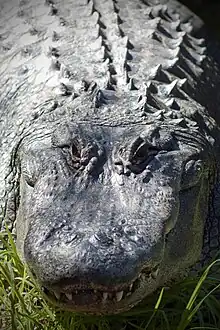Brevirostres
Brevirostres is a paraphyletic group of crocodilians that included alligatoroids and crocodyloids. Brevirostres are crocodilians with small snouts, and are distinguished from the long-snouted gharials. It is defined phylogenetically as the last common ancestor of Alligator mississippiensis (the American alligator) and Crocodylus niloticus (the Nile crocodile) and all of its descendants.[1] This classification was based on morphological studies primarily focused on analyzing skeletal traits of living and extinct fossil species, and placed the gharials outside the group due to their unique skull structure,[2] and can be shown in the simplified cladogram below:[3]
| Crocodylia |
| ||||||||||||
| Brevirostres Temporal range: Late Cretaceous - Recent, | |
|---|---|
 | |
| American alligator (Alligator mississippiensis) | |
| Scientific classification | |
| Domain: | Eukaryota |
| Kingdom: | Animalia |
| Phylum: | Chordata |
| Class: | Reptilia |
| Order: | Crocodilia |
| (unranked): | Brevirostres von Zittel, 1890 |
| Groups included | |
| Cladistically included but traditionally excluded taxa | |
However, recent molecular studies using DNA sequencing have rejected Brevirostres upon finding the crocodiles and gavialids to be more closely related than the alligators.[4][5][6][7][8] The new clade Longirostres was defined by Harshman et al. in 2003,[4] and can be shown in the cladogram below:
| Crocodylia |
| ||||||||||||
History
Brevirostres was first named by Karl Alfred von Zittel in 1890. Von Zittel considered Gavialis, the gharial, to be closely related to Tomistoma, the false gharial, and excluded them from the group. Tomistoma, as its name implies, is traditionally not considered closely related to Gavialis, but instead classified as a crocodylid. Under this classification, all members of Brevirostres are brevirostrine, or short-snouted. Recent molecular analyses support von Zittel's classification in placing Tomistoma as a close relative of Gavialis. If this classification is accepted, Brevirostres can be considered redundant with Crocodylia, as the two names would refer the same clade. Brevirostres would not, however, be a junior synonym of Crocodylia, as the two names have different definitions. [9]
References
- Brochu, C. A. (2003). "Phylogenetic approaches toward crocodylian history". Annual Review of Earth and Planetary Sciences. 31 (31): 357–97. Bibcode:2003AREPS..31..357B. doi:10.1146/annurev.earth.31.100901.141308.
- Holliday, Casey M.; Gardner, Nicholas M. (2012). Farke, Andrew A (ed.). "A new eusuchian crocodyliform with novel cranial integument and its significance for the origin and evolution of Crocodylia". PLOS ONE. 7 (1): e30471. Bibcode:2012PLoSO...730471H. doi:10.1371/journal.pone.0030471. PMC 3269432. PMID 22303441.
- Brochu, C.A. (1997). "A review of "Leidyosuchus" (Crocodyliformes, Eusuchia) from the Cretaceous through Eocene of North America". Journal of Vertebrate Paleontology. 17 (4): 679–697. Bibcode:1997JVPal..17..679B. doi:10.1080/02724634.1997.10011017. JSTOR 4523857.
- Harshman, J.; Huddleston, C. J.; Bollback, J. P.; Parsons, T. J.; Braun, M. J. (2003). "True and false gharials: A nuclear gene phylogeny of crocodylia" (PDF). Systematic Biology. 52 (3): 386–402. doi:10.1080/10635150309323. PMID 12775527. Archived from the original (PDF) on 2022-10-09. Retrieved 2021-07-19.
- Gatesy, J.; Amato, G. (2008). "The rapid accumulation of consistent molecular support for intergeneric crocodylian relationships". Molecular Phylogenetics and Evolution. 48 (3): 1232–1237. doi:10.1016/j.ympev.2008.02.009. PMID 18372192.
- Erickson, G. M.; Gignac, P. M.; Steppan, S. J.; Lappin, A. K.; Vliet, K. A.; Brueggen, J. A.; Inouye, B. D.; Kledzik, D.; Webb, G. J. W. (2012). Claessens, Leon (ed.). "Insights into the ecology and evolutionary success of crocodilians revealed through bite-force and tooth-pressure experimentation". PLOS ONE. 7 (3): e31781. Bibcode:2012PLoSO...731781E. doi:10.1371/journal.pone.0031781. PMC 3303775. PMID 22431965.
- Michael S. Y. Lee; Adam M. Yates (27 June 2018). "Tip-dating and homoplasy: reconciling the shallow molecular divergences of modern gharials with their long fossil". Proceedings of the Royal Society B. 285 (1881). doi:10.1098/rspb.2018.1071. PMC 6030529. PMID 30051855.
- Hekkala, E.; Gatesy, J.; Narechania, A.; Meredith, R.; Russello, M.; Aardema, M. L.; Jensen, E.; Montanari, S.; Brochu, C.; Norell, M.; Amato, G. (2021-04-27). "Paleogenomics illuminates the evolutionary history of the extinct Holocene "horned" crocodile of Madagascar, Voay robustus". Communications Biology. 4 (1): 505. doi:10.1038/s42003-021-02017-0. ISSN 2399-3642. PMC 8079395. PMID 33907305.
- Brochu, C.A. (1999). "Phylogenetics, taxonomy, and historical biogeography of Alligatoroidea". Memoir (Society of Vertebrate Paleontology). 6: 9–100. doi:10.2307/3889340. JSTOR 3889340.